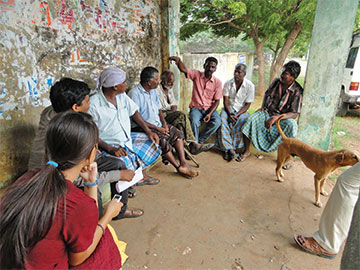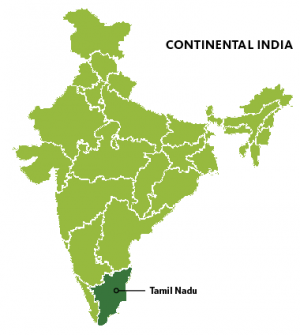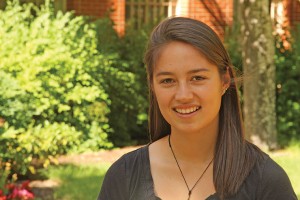 Social Sciences
Social Sciences
Passage to India

It was hot and dirty, and the men sitting in a semicircle around Irene Klock were yelling at her.
How had she gotten herself into this? Why had she chosen to come to this remote village in India, where she was drawing the ire of local farmers simply by asking questions about an irrigation project?
The farmers kept yelling, and Klock (below) kept her voice recorder running. She didn’t speak a word of the Tamil language but, thankfully, she wasn’t alone; her translator, Mr. Mathivanan, helped keep the situation from escalating.
Klock finished her questions and the two left quickly. She learned later that the men, mistaking her for an official, had been demanding answers about a lagging government project to bring water—to bring opportunity—to their parched land.
Oh, the glamorous life of a globe-trotting geographer.
Learning by Doing
In fall 2014, Klock, majoring in Japanese and geography, spent four months in southeast India surveying farmers about a project to irrigate their land by linking rivers in the area. She is a self-described kinesthetic learner—she learns by doing—and in choosing this research project, Klock was looking for a real-life learning experience outside of the classroom. She found it.
River linking, common in India, is the use of canals to connect rivers, bringing water to dry areas and supporting agriculture, drinking water, and flood control. Drawbacks include loss of land, increased contamination of rivers, and damage to ecosystems and wildlife.
It begs the kind of question that appeals to a student in environmental geography such as Klock: what are the ramifications of fundamentally altering the relationship between a people and their natural environment?
Klock had been searching for research projects abroad that combined farming and irrigation. She connected with a nonprofit organization in India called ATREE (Ashoka Trust for Research in Ecology and the Environment), which is working to conserve the country’s biodiversity. Paying her own way, Klock flew to India and, after receiving training at the organization’s office in urban Bengaluru, she and her translator headed  for Tamil Nadu, a southeast Indian state famed for its Hindu temples.
for Tamil Nadu, a southeast Indian state famed for its Hindu temples.
On paper, Klock’s assignment seemed simple enough: She was to interview villagers from water-deprived districts, gathering public opinion on a new river-linking channel that was only partially complete. Mathivanan would be her intermediary, gaining permission from village leaders for the young woman to talk to farmers.
In reality, it was a project that pushed Klock out of her comfort zone. She endured pangs of homesickness and conditions for the project were less than ideal: temperatures routinely topped 100 degrees and sometimes the setting for the interviews was no more luxurious than a concrete bench at a bus station.
Pipettes and Recorders
Klock also wrestled with the challenge of the work itself. Her project was one in “qualitative” research—which prizes observations of the world around you—as compared to “quantitative” research, in which answers are typically derived from calculations and formulas.
“I’ve taken chemistry and biology—I know how to do research with quantitative data,” Klock said. “For this, my methods were different. I wasn’t using a pipette, I was using a voice recorder. How I interpreted the data was different, as well. It was more like writing a story rather than writing a scientific paper.”
Klock (right) visited 12 villages, conducting hourlong interviews with groups that varied from five to 20 people. She was armed with 20 questions meant to spark conversations on the new canal project; the participants were all Indian men, ages 40 and older.
As she conducted the interviews, and during analysis of the farmers’ responses later, Klock listened for patterns or repeated references to the canal’s benefits or detriments—say, the ability to grow cash crops or loss of land to make way for the project. Working with ATREE, she organized this information into a narrative with numerical data. Klock also compared current and expected crop harvests and assessed each village’s dependency on agriculture as a livelihood.
Klock found that the villages, without exception, supported the new canal, even though a third of the groups could expect to lose land for the project. With irrigation, farmers hoped to add an additional crop cycle and to increase the production of “wet” crops such as paddy rice and cash crops such as chilies and sugar cane.
Klock also identified problems that might have influenced her results, including mistakes in translation and transcription. Throughout the experience, she noted, there was also a “recurring misconception” that the research was for governmental purposes.
“It is possible that focus group discussion participants may have answered questions or made comments under the impression that their answers would influence government assistance for their village,” Klock wrote. “The credibility of the data collected from some of the focus group discussions became uncertain after participants changed their answers to similar questions later on in the discussions . . . and after villages claimed they were water-poor when data showed that they received high amounts.”
Amazing Adaptability
While ATREE helped Klock analyze and organize her data, she also leaned on her advisor at the UO, Leslie McLees, the department’s undergraduate coordinator and an adjunct instructor.
Before Klock left, the two mapped out McLees’ expectations for the project: a research report, classroom presentation, and submission to the university’s undergraduate symposium, all of which Klock completed. While Klock was abroad, McLees also talked the young researcher through some of the more frustrating moments of the experience.
 “I was struggling, I was living alone, it is the hardest country I’ve ever lived in,” Klock (right) said. “It was probably the hardest four months of my life.”
“I was struggling, I was living alone, it is the hardest country I’ve ever lived in,” Klock (right) said. “It was probably the hardest four months of my life.”
McLees, citing the logistical challenges that Klock overcame for the project—international travel, language barriers, and a cultural divide—said the student showed “amazing adaptability and maturity.”
Klock’s project was an excellent example of the geographer’s goal of understanding how political, economic, and cultural processes play out in a particular place, McLees said—in this case, how a state water project affects people at the local level.
“When students head out into the field and have extended stays in a place and are open to the variety of people they will encounter, they bring that back with them,” McLees said. “Rather than seeing people as helpless or poor or uneducated, students who approach these places with an open mind—as Irene did—can help us see that the reality is far more complex.”
For Klock, there is no better example than the friendship she developed with her translator, Mathivanan.
Initially, she misinterpreted his quietness as aloofness; he seemed unapproachable and it was intimidating to ask him questions, Klock said. But as the two spent more time together—and navigated together through the rigors of the experience—they became closer.
“After that very hard focus group discussion, we were driving in the car and he said, ‘I’m sorry about that. You’re very brave for coming out here as a young woman,’” Klock said. “Being able to bond with him over that made me more comfortable for the rest of the time. We became friends.”
—By Matt Cooper


 Twitter
Twitter Facebook
Facebook Forward
Forward